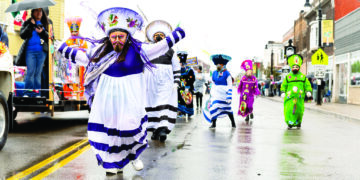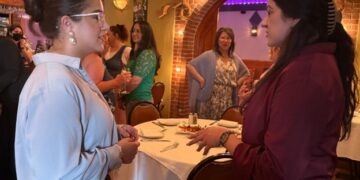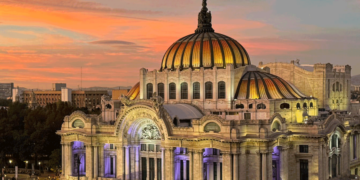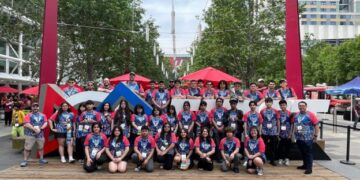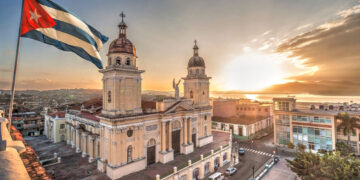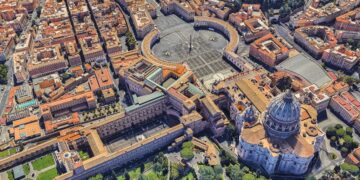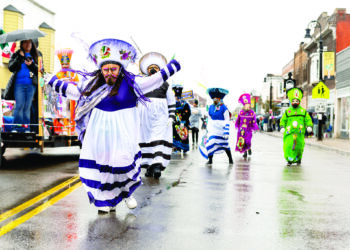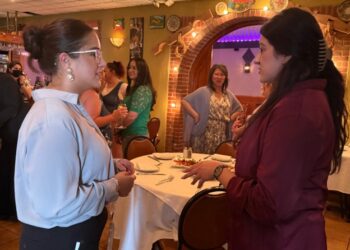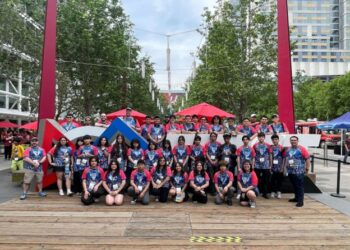Artwork by Wayne State University’s Center for Latino/a and Latin American Studies (CLLAS) is currently featured in the Detroit Institute of Arts’ annual Dia de los Muertos exhibition. CLLAS students, faculty, staff and alumni have collaborated to create an ofrenda — commonly referred to as altars — which have been at the core of Dia de los Muertos for centuries. The ofrenda, titled “El Fuego Se Equivoco,” which translates to “The Fire Was Mistaken,” is a tribute to those who have voiced resistance but were silenced. The installation will be on display through Nov. 5.
Literally translated to “offering,” the ofrenda has roots in what is now southern Mexico, and in Guatemala, where Indigenous people would celebrate, commemorate and connect with their deceased ancestors through displays of food and drink, music, flowers and iconography.
Alicia Diaz, who is both faculty and a CLLAS alumna, led the project and said ofrendas are part of a rich tradition celebrating the ongoing communication between the living and the dead. She explained that celebrations historically took place at burial sites and in the streets of a community. However, in the United States, until the latter part of the 20th century, the practice was relegated by cultural intolerance and anti-Mexican sentiment into private homes or churches. With the rise of the Chicano Power Movement in the 1960s, Los Angeles artisans helped move ofrendas back into public spaces.
“It’s a bittersweet celebration, and without a line of separation between the secular and the spiritual, between the living and the dead, or between grief and joy. The accepted and expected notion was that ancestors lived on beyond physical death, and so they were celebrated the same colorful way as the living — with food, music, flowers and more,” said Diaz. “The ofrenda was traditionally viewed as a doorway, to bridge those fluid, permeable realms.”
Tradition turned art
Ofrendas have evolved over time as a popular art form, varying widely across the United States with nuances tied to the complexities of the various Latin American identities across the country. The DIA’s exhibit will feature 14 ofrendas, including an installation crafted by CLLAS alumna and artist Josefina Diaz. CLLAS first participated in the DIA’s ofrendas exhibition in 2019. While they vary widely and take on the identities of their respective creators and communities, Diaz said all ofrendas have one thing in common: They tell a story.
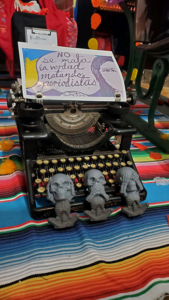
“The ofrenda has become an incredibly complex expression of Mexican, Chicano and Latinx communities, regardless of origin. But it’s clear that they resonate with everyone,” Diaz said, noting the diversity of artists and themes featured in the DIA’s annual exhibits. “One of the most moving installations that I saw last year here in Detroit was dedicated to George Floyd and Breonna Taylor. In 2019, during the public Q&A session hosted by the DIA with the ofrenda artists for that year, I was touched to hear the personal grieving experience of a woman in the audience who claimed no ties to the Latinx community. This is an art form for all to find meaning and healing.”
Diaz, who teaches Introduction to Latin American Studies, said the project is one of the many ways she and her colleagues at CLLAS work to help students see themselves in the American story.
“We take an approach that really empowers students to see themselves at the core of the American story, not on the periphery, not as a footnote, not as something to be thought about one day out of the month,” she said. “America is a Latinx story with origins that predate America’s Detroit story. The Latinx community here has been here for a century — you are not the ‘other.’ It’s truly a privilege to support them in that expression.”
Sending a message
CLLAS’ ofrenda, “El Fuego Se Equivoco” (“The Fire Was Mistaken”), pays tribute to artists, authors, journalists, activists and others whose voices of resistance have been silenced. It was inspired by the 1562 mass destruction of Mayan books, art and other relics by European clerics in the Yucatan peninsula in an attempt to “drive the demons” from the Indigenous peoples’ hearts. The installation’s themes of censorship and resistance draw on a grounding philosophy of the Dia de los Muertos: that death does not mean an end, and that while one’s voice may be silenced, an idea or a movement can live forever. Included are representations of silenced voices that cut across the Americas, including the Caribbean, South America, the United States, Mexico, Central America and beyond.
“For generations and across cultures, people have paid very dear prices — some of them, their lives — for refusing to remain silent,” said Diaz. “With our ofrenda, we mourn and honor them, but very much also step into the future. It’s a gateway between today, yesterday and tomorrow. It’s about drawing lessons from the past and empowering people today.”
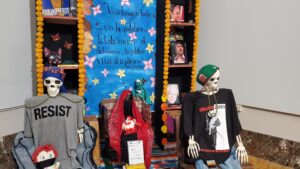
The installation is anchored by a pair of bookcases framing an archway featuring a painted canvas and flanked by antique desks, benches, typewriters, books, records and more. The ofrenda also includes more traditional elements, including candles, marigolds, Mexican fabric, skeletons and sugar skulls.
Alondra Cruz Almestica, a junior in the College of Education and a McNair Scholar, painted the focal point of the archway’s canvas, which features a quote from internationally recognized Indigenous Honduran activist Berta Cáceres, who was murdered in 2016 in response to her environmental activism.
“As someone of Puerto Rican descent, being welcomed to work in this space was an honor,” Cruz Almestica said. “The meaning of the ofrenda is touching — it’s an opportunity to show the world that we remember and carry on Cáceres message.”
Members of the School of Medicine’s chapter of the Latino Medical Student Association, including Rafael Ramos, Tannia Rodriguez, Jose Lopez, Ingrid Rocha, Sophia Gandarillas and Karen Zapien, collaborated with CLLAS on the ofrenda. The group interpreted barriers to and biases within health care as a form of censorship. Their interpretation is represented by a pair of Catrina skeletons — one a mother in need and another a health care worker in scrubs.
“The DIA is such a special place for our community — especially considering the Rivera courts and the frescos,” said Ramos. “With this piece, we’re able to express the disconnect between some patients in need of care and health care professionals who want to help them.”
First-year student Diana Rodriguez, who is majoring in art in the College of Fine, Performing and Communication Arts, led the design of a “Xolo” featured within the installation. The Xoloitzcuintli is a Mexican breed of dog that in Mexica (Aztec) tradition served as a guide dog to the underworld.
“It’s been my first experience working on an ofrenda, and being able to do so with a community of artists who will have our work displayed at the DIA has been incredible,” said Rodriguez.
To learn more about CLLAS, visit las.wayne.edu. The DIA is located at 5200 Woodward Avenue. Admission is free for residents of Wayne, Oakland and Macomb counties.
The Ofrendas Exhibit at the Detroit Institute of Arts runs through November 5, 2023. Entrance to the exhibit is free with general admission. Museum admission is free for residents of Macomb, Oakland and Wayne Counties.
Conectando a los vivos y a los muertos, el Pasado y el Futuro a través del arte
El Centro para Latinos y Estudios Latinoamericanos ha abierto una exposición de ofrendas, en el Instituto de Artes de Detroit
Las obras de arte del Centro para Latinos y Estudios Latinoamericanos (CLLAS) de la Universidad de Wayne State se presentan actualmente en la exposición anual del Día de los Muertos del Instituto de Artes de Detroit. Los estudiantes, profesores, personal y exalumnos de CLLAS han colaborado para crear una ofrenda, comúnmente conocida como altar, que ha sido el centro del Día de los Muertos durante siglos. La ofrenda, titulada “El Fuego Se Equivoco”, es un homenaje a quienes expresaron resistencia, pero fueron silenciados. La instalación estará en exhibición hasta el 5 de noviembre.
Las ofrendas tienen sus raíces en lo que hoy es el sur de México y en Guatemala, donde los pueblos indígenas celebraban, conmemoraban y se conectaban con sus ancestros fallecidos a través de exhibiciones de comida, bebida, música, flores e imágenes.
Alicia Díaz, profesora y exalumna de CLLAS, dirigió el proyecto y comentó que las ofrendas son parte de una rica tradición que celebra la comunicación continua entre los vivos y los muertos. Explicó que históricamente las celebraciones se llevaban a cabo en los cementerios y en las calles de una comunidad. Sin embargo, en Estados Unidos, hasta finales del siglo XX, la práctica quedó relegada por la intolerancia cultural y el sentimiento antimexicano a hogares privados o iglesias. Con el surgimiento del Movimiento del Poder Chicano en la década de 1960, los artesanos de Los Ángeles ayudaron a trasladar las ofrendas de regreso a los espacios públicos.
“Es una celebración agridulce, y sin una línea de separación entre lo secular y lo espiritual, entre los vivos y los muertos, o entre el dolor y la alegría. La noción aceptada y esperada era que los antepasados vivieron más allá de la muerte física, por lo que se les celebraba de la misma manera colorida que los vivos: con comida, música, flores y más”, dijo Díaz. “La ofrenda era vista tradicionalmente como una puerta para unir esos reinos fluidos y permeables”.
La Tradición se ha convertido en arte
Las ofrendas han evolucionado con el tiempo, como una forma de arte popular, variando ampliamente en los Estados Unidos con matices ligados a las complejidades de las diversas identidades latinoamericanas en todo el país. La exhibición del DIA contará con 14 ofrendas, incluida una instalación realizada por la exalumna y artista de CLLAS Josefina Díaz. CLLAS participó por primera vez en la exposición de ofrendas de DIA en 2019. Si bien varían ampliamente y adoptan las identidades de sus respectivos creadores y comunidades, Díaz dijo que todas las ofrendas tienen una cosa en común: cuentan una historia.

“La ofrenda se ha convertido en una expresión increíblemente compleja de las comunidades mexicanas, chicanas y latinas, independientemente de su origen. Pero está claro que resuena en todos”, dijo Díaz, destacando la diversidad de artistas y temas presentados en las exhibiciones anuales de la DIA. “Una de las instalaciones más conmovedoras que vi el año pasado aquí en Detroit estuvo dedicada a George Floyd y Breonna Taylor. En 2019, durante la sesión pública de preguntas y respuestas organizada por la DIA con los artistas de la ofrenda de ese año, me conmovió escuchar la experiencia de duelo personal de una mujer en la audiencia que afirmaba no tener vínculos con la comunidad latina. Esta es una forma de arte para que todos encuentren significado y sanación interior”.
Díaz, quien enseña Introducción a los Estudios Latinoamericanos, dijo que el proyecto es una de las muchas formas en que ella y sus colegas de CLLAS trabajan para ayudar a los estudiantes a verse a sí mismos en la historia estadounidense.
“Adoptamos un enfoque que realmente permita a los estudiantes verse a sí mismos en el centro de la historia estadounidense, no en la periferia, no como una nota a pie de página, no como algo en lo que pensar un día al mes”, dijo. “Estados Unidos es una historia latina con orígenes anteriores a la historia de Detroit en Estados Unidos. La comunidad latina ha estado aquí durante un siglo; ustedes no son el ‘otro’. Es realmente un privilegio apoyarlos en esa expresión”.
Enviando un mensaje
La ofrenda de CLLAS, El Fuego Se Equivoco, rinde homenaje a artistas, autores, periodistas, activistas y otras personas cuyas voces de resistencia han sido silenciadas. Se inspiró en la destrucción masiva de libros, arte y otras reliquias mayas en 1562 por parte de clérigos europeos en la península de Yucatán en un intento de “expulsar a los demonios” de los corazones de los pueblos indígenas. Los temas de censura y resistencia de la instalación se basan en una filosofía fundamental del Día de los Muertos: que la muerte no significa un fin y que, si bien la voz de uno puede ser silenciada, una idea o un movimiento puede vivir para siempre. Se incluyen representaciones de voces silenciadas que atraviesan América, más allá del Caribe, Sudamérica, Estados Unidos, México y Centroamérica.
“Durante generaciones y en todas las culturas, la gente ha pagado precios muy altos (algunos de ellos, con sus vidas) por negarse a permanecer en silencio”, dijo Díaz. “Con nuestra ofrenda, los lloramos y los honramos, pero también intervenimos Al futuro. Es una puerta de entrada entre el hoy, el ayer y el mañana. Se trata de aprender lecciones del pasado y empoderar a las personas de hoy”.

La instalación está anclada por un par de estanterías que enmarcan un arco con un lienzo pintado y flanqueadas por antiguos escritorios, bancos, máquinas de escribir, libros, discos y otros artefactos. La ofrenda también incluye elementos tradicionales, como velas, caléndulas, telas mexicanas, esqueletos y calaveras de azúcar.
Alondra Cruz Alméstica, estudiante de tercer año de la Facultad de Educación y becaria McNair, pintó el punto focal del lienzo del arco, que presenta una cita de la activista indígena hondureña internacionalmente reconocida Berta Cáceres, quien fue asesinada en 2016 en respuesta a su activismo ambiental.
“Como alguien de ascendencia puertorriqueña, ser bienvenido a trabajar en este espacio fue un honor”, dijo Cruz Alméstica. “El significado de la ofrenda es conmovedor: es una oportunidad para mostrarle al mundo que recordamos y llevamos el mensaje de Cáceres”.
Miembros del capítulo de la Asociación Latina de Estudiantes de Medicina de la Facultad de Medicina, incluidos Rafael Ramos, Tannia Rodríguez, José López, Ingrid Rocha, Sophia Gandarillas y Karen Zapien, colaboraron con CLLAS en la ofrenda. El grupo interpretó las barreras y los prejuicios dentro de la atención médica como una forma de censura. Su interpretación está representada por un par de esqueletos de Catrina: uno de una madre necesitada y otro de un trabajador de la salud con bata médica.
“El DIA es un lugar tan especial para nuestra comunidad, especialmente considerando los patios de Rivera y los frescos”, dijo Ramos. “Con esta pieza, podemos expresar la desconexión entre algunos pacientes que necesitan atención y los profesionales de la salud que quieren ayudarlos”.
La estudiante de primer año Diana Rodríguez, quien se especializa en arte en la Facultad de Bellas Artes, Artes Escénicas y de la Comunicación, dirigió el diseño de un “Xolo” que aparece dentro de la instalación. El Xoloitzcuintli es una raza de perro mexicana que en la tradición mexica (azteca) servía como perro guía hacia el inframundo.
“Ha sido mi primera experiencia trabajando en una ofrenda, y poder hacerlo con una comunidad de artistas que exhibirán nuestro trabajo en el DIA ha sido increíble”, dijo Rodríguez.
Para obtener más información sobre CLLAS, visite las.wayne.edu. El DIA está ubicado en 5200 Woodward Avenue. La entrada es gratuita para los residentes de los condados de Wayne, Oakland y Macomb.
La exhibición de Ofrendas en el Instituto de Artes de Detroit estará abierta hasta el 5 de noviembre de 2023. La entrada a la exhibición es gratuita con entrada general. La entrada al museo es gratuita para los residentes de los condados de Macomb, Oakland y Wayne.
Traducción por Carmen Elena Luna.

